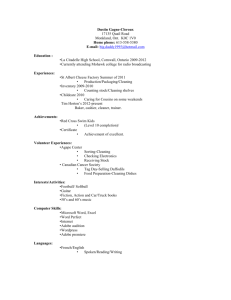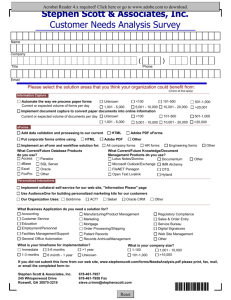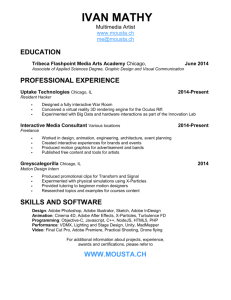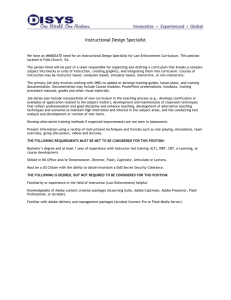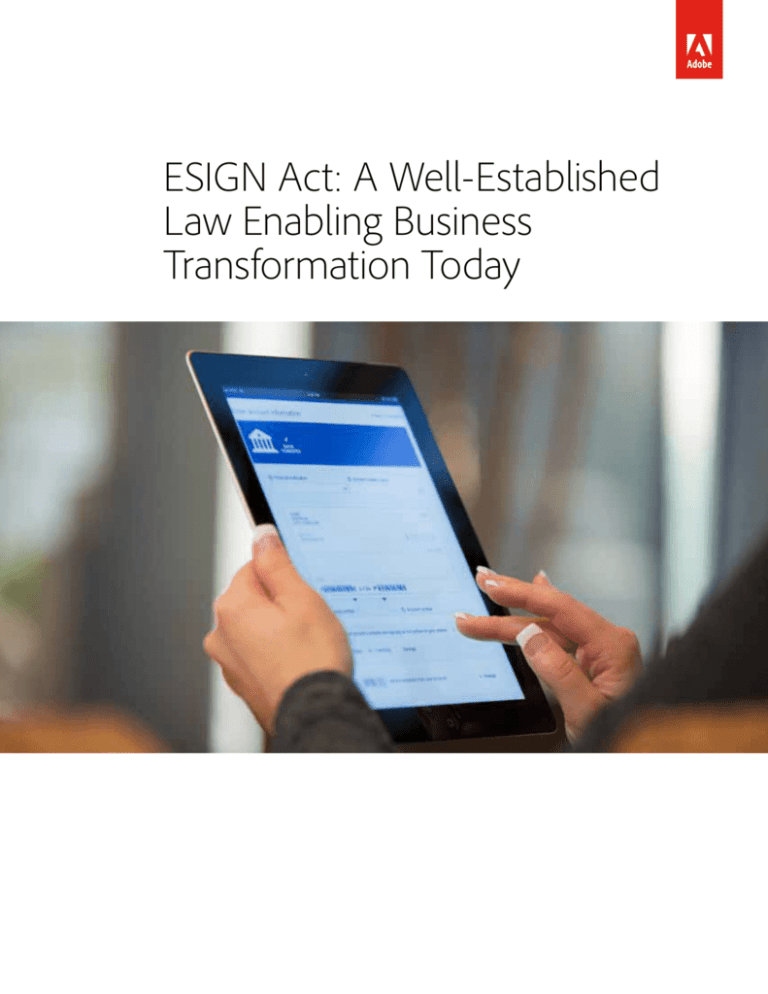
ESIGN Act: A Well-Established
Law Enabling Business
Transformation Today
Adobe Document Cloud White Paper
ESIGN Act: A Well-Established Law Enabling
Business Transformation Today
A guide to electronic signatures in the United States for corporate
­counsels and compliance officers
Table of contents
1:ESIGN Act makes
e-signatures legal
2:E-signature solution
selection is key to
meeting industry
requirements
3:Court rulings focus on
intent to be bound and
processes used
4:E-signatures accelerate
key business processes
4:The eSign services
in Adobe Document
Cloud are the trusted
solution used by many
of the Fortune 1000
5:Without a fully digital
business, the greatest
risk is being left behind
On June 30, 2000, President Bill Clinton signed the Electronic Signatures in Global and National Commerce Act
(ESIGN Act) into law without a pen. Instead, he used an electronic signature. This ground-breaking law
addresses e-signatures as well as electronic records, both of which are commonly used in commerce today. An
e-signature was granted the same status as a written signature under the terms of this legislation; however, it is
important to note that simply placing a symbol on a document does not, in and of itself, create an enforceable
contract. Those who are concerned about the question of legality must be well informed about the various
requirements associated with the use of e-signatures. For most, the first and foremost question may be, “Are
e-signatures legal?”
The simple answer is, yes, e-signatures are legal. This paper discusses several factors relating to the legality of
e-signatures in various applications and among different industries, with their associated regulatory
environments. It also explores the benefits of adopting a digital document solution that enables real-time
signatures. When used along with sound and consistent best practices, the optimal solution can not only create
an enforceable contract, but also improve document creation, storage, retrieval, and audit trails.
E-signatures are fast becoming an integral part of our business landscape. Leading companies today, even in
the most conservative and regulated industries such as financial services and healthcare, are rapidly adopting
e-signatures to accelerate key business processes. For example, a leading healthcare company estimates that
by using the eSign services in Adobe Document Cloud, formerly known as Adobe EchoSign, they decreased
transaction costs from US$16 to US$1.50. These cost-saving benefits, in addition to the improved ease and
efficiency of transacting business, will undoubtedly fuel the continued growth of e-signatures.
ESIGN Act makes e-signatures legal
The ESIGN Act of 2000 is a federal law that has given e-signatures the same status as handwritten signatures.
Due to federal preemption, the ESIGN Act allows e-signatures in all 50 states. E-signatures use technology that
allows a far greater degree of assurance of attribution, authentication, and security.
The ESIGN Act:
• Satisfies any statute, regulation, or rule of law that requires handwritten signatures on documents, provided
the consumer has affirmatively consented to use e-signatures and not withdrawn that consent
• Assures the contract may be used in a court of law as long as surrounding processes are well designed and
implemented and the usual elements of a contract exist
• Prevents denial of legal effect, validity, or enforceability of an e-signed document solely because it is in
electronic form or was used in the contract’s formation
• Helps substantiate a document for admissibility in court due to the ESIGN Act’s consumer consent
According to the ESIGN Act, an e-signature is defined as “an electronic sound, symbol, process attached to or
logically associated with a contract or other record and executed or adopted by a person with the intent to sign
the record and be legally bound.” The key takeaway for purposes of contract enforcement is that the electronic
sound, symbol, or process must be both associated with a contract or other document and adopted by the
signatory, by some act, with the intent to be bound.
Adobe Document Cloud White Paper
1
E-signature solution selection is key to meeting industry requirements
The broad nature of the ESIGN Act created an opportunity for regulators in various industries to make specific
rules pertaining to the use of e-signatures. The ESIGN Act provides that both federal and regulatory agencies
have the authority to interpret and apply the law in the context of their industries. Understanding the
implications of e-signature use in a specific industry depends upon consideration of the reason the document
was created. If the document is being generated for business, consumer, or commercial transactions, the ESIGN
Act generally supersedes any regulatory agency’s preexisting requirement that a record be kept on paper.
However, if it is being created principally for governmental requirements not related to commercial
transactions, the ESIGN Act may not apply.
The use of electronic signatures may satisfy the requisite regulatory compliance in your industry by providing
the authentication, authorization, accountability, audit, and security needed to follow your industry’s particular
laws. The following table offers a summary of several major industry regulations coupled with the important
features of a robust e-signature solution relating to those regulations.
Industry regulation
Overview of regulation
What to look for in an e-signature solution
Sarbanes-Oxley Act
(SOX)
SOX requires that publicly held corporations
establish verifiable security controls to protect
against disclosure of confidential data and
carefully track personnel data to detect
fraud-related tampering.
Solution should include robust and
comprehensive security safeguards such as
infrastructure security and data security,
including application-level encryption using
Secure Sockets Layer (SSL) and 256-bit
Advanced Encryption Standard (AES)
encryption, to safeguard the confidential
information in an electronic document.
Gramm-Leach-Bliley
Act (GLBA)
GLBA is intended to protect consumers’ privacy
and provide security for consumer personal
information, requiring notification and opt-out
procedures and limiting the reuse or marketing
of consumer personal information.
The technology must provide for the safety of
any personal information captured, clearly
explain notification and opt-out procedures to
the consumer, and strictly limit reuse or
marketing of a consumer’s personal information.
Dodd-Frank Act
(DFA)
DFA created the Consumer Financial
Protection Bureau (CFPB), a council designed
to oversee financial institutions and reform
securitization. E-signatures comply provided
that they adhere to the consent requirements
of the federal ESIGN Act.
The solution must provide for active consent
of the signatory prior to applying the
e-signature to the document.
Federal Deposit
Insurance
Corporation (FDIC)
FDIC regulations relating to electronic filings
and signatures require a signature to appear in
“typed form” and require an electronic copy of
the physical signature for anything
electronically signed.
The solution should provide a “typed form”
appearance as well as maintain an electronic
copy of the physical signature for any document
executed with an electronic signature.
Health Insurance
Portability and
Accountability Act
of 1996 (HIPAA)
HIPAA places stringent requirements on
healthcare providers (also called “Covered
Entities”) to protect sensitive health
information.
Companies must work only with HIPAAcompliant service providers and have a Business
Associate Agreement (BAA) in place with those
providers. The solution must support HIPAA’s
stringent privacy and security requirements to
protect sensitive data, and the company’s BAA
must meet all HIPAA requirements.
Internal Revenue
Service (IRS)
Currently, the use of e-signatures on IRS forms
is approved on an ad hoc basis. According to
Announcement 2013-8, the IRS requires that
signatures meet five core requirements that
align precisely with the ESIGN Act.
The solution must show that the electronic
form of signature that is adopted by the
signatory with the intent to be bound is
attached to the record being signed,
authenticated, and properly preserved and
stored.
McCarran-Ferguson
Act (Public Law 15)
The ESIGN Act expressly states that it applies
to the business of insurance to comply with the
McCarran-Ferguson Act. The ESIGN Act also
includes a specific provision that relieves
insurance agents and brokers from liability
under certain conditions.
The solution needs to comply with the ESIGN
Act such that insurance agents can meet the
requirement that an action be legally
attributable to a person intending to be bound.
Simple compliance with the Uniform
Electronic Transactions Act (UETA) does not
achieve this industry best practice.
Adobe Document Cloud White Paper
2
Court rulings focus on intent to be bound and processes used
The courts are catching up to the reality of e-signature technology in the modern business climate. The main
issues that result in legal conflicts do not tend to arise around the technicalities associated with an e-signature
but rather with the various elements of contract formation, that is, the facts surrounding creation of the
contract. So, processes relating to capture, security, storage, and retention are important.
For example, the New York Supreme Court addressed whether precise adherence to the definition of an
e-signature is required to create a valid agreement. In Forcelli v Gelco (2013) 109 A.D.3d 244, a case involving
settlement negotiations via email, the court concluded that a farewell statement at the end of the email was a
signed and “subscribed” signature even though it did not technically constitute an e-signature according to statute.
Evidence of a clear intent to be bound is important. Courts generally require evidence of an awareness of the
terms of the contract and an act that exhibits assent or intent to be bound prior to signing a document or using
a service, like clicking an “I agree” button. However, some courts do look at the circumstances surrounding the
transaction for other indications of assent and have held that a contract is enforceable even without such an
overt indication.
Additional important topics covered by the courts are evidentiary issues such as preservation and admissibility
of electronically stored information (ESI). At the most basic level, such information must be properly preserved
and then admitted. The leading case on the admissibility of ESI, Lorraine v Markel AM. Inc. Co. (2007) 241 F.R.D.
534, addressed a failure to comply with the rules of evidence surrounding the submission of extrinsic
information to resolve an ambiguity in an arbitration contract. The court analyzed the admissibility and
addressed the importance of ensuring that a document is authentic or that it is what it claims to be, that it is an
accurate duplicate of the original to satisfy the original writing rule, and that business records are kept in the
normal course of business to overcome the hearsay exclusionary rule.
The bottom line is that your documents are only as good as the process you used to obtain them. In the event
of a legal challenge to your document, your electronically stored information must have been properly
obtained, preserved, produced, and ultimately admitted into evidence. The success of this effort may in large
part depend upon whether you diligently followed your own process. And if you don’t provide the appropriate
level of assurances, the document could be deemed inadmissible.
Recommended process and best practices for adopting e-signatures
When adopting e-signatures, your process should involve the following:
• Authentication—Authenticate the signatory’s identity.
• Consent—Account for consent.
• Intent to be bound—Establish intent to be bound.
• Attribution—Establish attribution to a particular individual and/or a representative of a company.
• Security—Provide a binding of the signature to the document and proof of nonalterability after the signature
has been affixed to the document.
• Record retention—Offer secure storage and access processes.
The process of creating a valid e-signature requires that the signer be identified and authenticated at the time
of the signature. To meet the requirements of state evidence laws on authentication and FRE 901(a), the law
generally requires that a proponent of a document produce sufficient evidence to support a finding that the
item is what he or she claims it to be, and that the signing process be sufficiently described to show that it
produces an accurate result.
Adobe Document Cloud White Paper
3
The following best practices can help guide you in developing your document creation, storage, and retention
processes to ensure admissibility of a document:
• Create an audit trail—Identify your signatory; which document was signed; and when the document was
signed, including date, time, and sequencing of events. Ensure that any changes to records do not obscure
previous entries. This audit trail also includes ensuring that the signatory affirmatively consented to the
e-signature process and has not withdrawn such consent.
• Secure the audit trail—Render the e-signed document unalterable within a secure “electronic vault.”
Securing the audit trail also describes the internal process ascribed to storing electronic records. Electronic
records must be capable of being retained and accurately reproduced for later reference.
• Create and maintain a retrieval process—Appoint a credible custodian of records to manage the process.
This person should also be able to testify to the secure steps taken by all company representatives in the
e-signature and e-storage process, rendering documents accurate and readily retrievable.
E-signatures accelerate key business processes
E-signatures can deliver quick and impressive ROI, while enabling significant improvements in security and
compliance. Some common use cases include:
“We can complete
contracts in minutes
and meet deadlines
that would have
been impossible
without leveraging
this type of
technology.”
Connie Brenton, director
of operations and chief
of staff, legal department,
NetApp
• Accelerate sales documents—Decrease the time to revenue and increase the deal closure rate by
automating the creation of electronic sales documents and contracts and enabling customers to sign
electronically. Integration of the e-signature process can be part of a CRM deployment, such as with
Salesforce.com, Microsoft Dynamics CRM, SAP, or NetSuite, so the entire process remains electronic. See
eSign services in Adobe Document Cloud case studies: Groupon, Ricoh UK, NetApp.
• Simplify employee onboarding and policy acknowledgements—Speed up HR processes such as offer
letters, new hire documents, and employee policy acknowledgements by eliminating printing, faxing, and
overnight mailing. The e-signature process can be standalone or embedded into a human capital
management system, such as Workday, Successfactors, or Taleo. See eSign services in Adobe Document
Cloud case studies: Telefonica, Denver Broncos, Foursquare.
• Streamline legal and procurement operations—Automate the process for nondisclosure agreements,
vendor contracts, and confidential business-to-business agreements. Standalone or integrated into a
contract management system such as Ariba Contract Management, SAP CLM, Oracle, or NetSuite,
e-signatures can accelerate the execution of contracts by as much as five times or more. See eSign services in
Adobe Document Cloud case studies: Leasedrive, TiVo, Kantar IT Partnership.
eSign services in Adobe Document Cloud are the trusted solution used by many
of the Fortune 1000
The eSign services in Adobe Document Cloud speed business, integrate with existing systems, and reduce
signature cycle times from days to minutes—all from the trusted leader in secure digital documents for over
25 years. Global companies choose eSign services in Adobe Document Cloud to drive business faster, enabling
real-time signatures and approvals—easily, securely, on any device.
With careful application design, rigorous security practices, and continued monitoring of the global landscape
via legal teams across 30 offices worldwide, Adobe enables companies to maintain compliance with federal
and industry regulations so they can have peace of mind. Following is a summary of how eSign services in
Adobe Document Cloud enable compliance with legal standards and best practices.
• ESIGN Act compliance—In the United States, Adobe warrants that eSign services in Adobe Document Cloud
are fully compliant with the ESIGN Act of 2000. In addition, they comply with Australia’s Electronic
Transactions Act, Canada’s Uniform Electronic Commerce Act (UECA), and the Electronic Communications
Act 2000 (c. 7) in the United Kingdom.
Adobe Document Cloud White Paper
4
“We initially looked
at eSign services
just for legal
contracts, but we’ve
discovered that it
has so many more
applications than
we expected. eSign
services in Adobe
Document Cloud
are helping us
streamline internal
and external
operations across
the company,
making it one of the
most value-added
products we’ve ever
seen at TiVo.”
Larry Denny,
vice president and
associate general
counsel, TiVo
• Robust security at every level—Adobe uses the same technologies and security engineering processes
relied upon by financial institutions and governments around the world. Each release of eSign services in
Adobe Document Cloud code, along with the infrastructure that supports them, is developed with the Adobe
Secure Product Lifecycle (SPLC) framework. The SPLC framework is a rigorous set of best practices,
processes, and tools used throughout product development, resulting in more secure code that safeguards
confidential information. Infrastructure security is achieved through a multilayered approach that includes
physical security, firewall security, real-time logging and monitoring, intrusion detection, and data security.
eSign services in Adobe Document Cloud are supported by state-of-the-art, geo-dispersed data centers to
provide data redundancy and availability. SSL and AES encryption safeguards the integrity of documents, in
motion and at rest. Authorization to access different data sets is based on user roles within the application.
The user must be a participant in the contract (such as the document sender or signer) to view or modify
the contract.
• Compliance with GLBA, HIPAA, PCI DSS, and the US-EU Safe Harbor Framework—eSign services in Adobe
Document Cloud generally meet or exceed the strict standards arising from the varied and complex
regulatory landscape. Contact your Adobe representative to learn more about how eSign services in Adobe
Document Cloud are designed to meet your specific regulatory compliance needs.
• Best-in-class e-signature support for strong legal protection—eSign services in Adobe Document Cloud
offer multiple authentication methods and allow for two-factor authentication. They also provide the ability
to define different authentication methods for different signatories. Signatories are required to provide their
consent to use the eSign services before their electronic signatures can be applied to the document. Every
document signed with eSign services in Adobe Document Cloud automatically generates an audit trail that
tracks every step in the signature process—from initial document preparation through signing and archiving.
This comprehensive audit trail is encrypted, digitally sealed, tamper evident, and stored securely so that it can
be used in court to help prove who signed a document and when they signed it.
Without a fully digital business, the greatest risk is being left behind
Digital and mobile technologies have become the standard for business communications today. Gartner
predicts that mobile device shipments will surpass 2.3 billion units globally by the end of 2015. Yet, many B2B
and B2C document transactions that require signatures remain stuck in the era of fax machines, filing cabinets,
and overnight mail. eSign services in Adobe Document Cloud, the e-signature solution offered by a company
with a long-standing history and a strong commitment to delivering secure digital document technology,
provides a low-risk, fast-ROI approach to securely digitizing your document processing.
For more information
Solution details: www.adobe.com/go/dc-enterprise
Adobe Systems Incorporated
345 Park Avenue
San Jose, CA 95110-2704
USA
www.adobe.com
Adobe, the Adobe logo, and EchoSign are either registered trademarks or trademarks of Adobe Systems Incorporated in the United States and/or other countries. All other
trademarks are the property of their respective owners.
© 2015 Adobe Systems Incorporated. All rights reserved. Printed in the USA.
2/15

